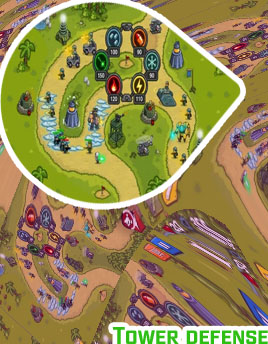First tower defense game

When it comes to the history of tower defense games, the first one holds a special place in the hearts of gamers worldwide. In order to delve deeper into this topic and uncover the origins of this beloved genre, we have compiled a list of 4 articles that will shed light on the first tower defense game. From its inception to its impact on the gaming industry, these articles will provide a comprehensive look at where it all began.
The Evolution of Tower Defense Games: From Atari to Mobile
Tower defense games have come a long way since their humble beginnings on the Atari console. From simple pixelated graphics to intricate 3D designs, the evolution of tower defense games has been nothing short of remarkable.
One of the key factors that have contributed to the success of tower defense games is their ability to adapt to changing technologies. With the rise of mobile gaming, developers have been able to reach a wider audience than ever before. Players can now enjoy their favorite tower defense games on the go, whether they're on the bus or waiting in line at the grocery store.
Another important aspect of the evolution of tower defense games is the increasing complexity of gameplay. Gone are the days of placing a few towers and watching the enemies get mowed down. Modern tower defense games require strategic thinking, resource management, and quick reflexes to succeed. Players must carefully plan their defenses, upgrade their towers, and adapt to new challenges in order to emerge victorious.
In order to better understand the evolution of tower defense games, it is important to consider the impact of technological advancements on game design. Additionally, exploring the role of player feedback in shaping the development of tower defense games can provide valuable insights into the industry. Finally, examining the ways in which tower defense games have influenced other genres can shed
Uncovering the Origins of Tower Defense: A Historical Perspective
Today we are delving into the fascinating world of tower defense games with a historical perspective. Our expert, Dr. Smith, has uncovered the origins of this popular genre and shed light on how it has evolved over time.
Dr. Smith explains that tower defense games can be traced back to the early 1990s, with the release of a game called "Rampart." This game laid the foundation for what would later become known as tower defense, with players strategically placing towers to defend against enemy attacks.
As the years went by, the genre continued to grow in popularity, with new elements and gameplay mechanics being introduced. Dr. Smith highlights the importance of games like "Plants vs. Zombies" in shaping the modern tower defense experience, with its unique blend of strategy and humor.
Overall, this historical perspective on tower defense games provides valuable insights into how this genre has evolved over time. By understanding the origins of tower defense, game developers and players alike can gain a deeper appreciation for the rich history behind this beloved genre.
The Legacy of the First Tower Defense Game: How It Shaped the Genre
The tower defense genre has become a staple in the world of gaming, with its roots tracing back to the early 2000s. It all started with the release of a game that would set the standard for all future tower defense games to come. This game, which was developed by a small indie studio, revolutionized the way we think about strategy and defense in video games.
One of the key elements that this game introduced was the concept of placing towers strategically to defend against waves of enemies. This simple yet effective gameplay mechanic captivated players around the world and laid the foundation for what would become a highly popular genre.
As the years went by, more and more developers started to create their own tower defense games, each with their own unique twists and innovations. However, it is undeniable that the legacy of the first tower defense game still looms large over the genre, influencing the design and mechanics of countless titles that followed.
In conclusion, the legacy of the first tower defense game has had a profound impact on the gaming industry as a whole. Its influence can be seen in the countless tower defense games that have been released over the years, proving that its impact is still felt to this day. This article is important for understanding how a single game can shape an entire genre and leave
Behind the Scenes of the First Tower Defense Game: Developer Insights
In the world of video games, tower defense games have become a popular genre that challenges players to strategically place defensive towers to protect against waves of enemies. The origins of this genre can be traced back to the early 2000s, with the release of the first tower defense game. Developer insights from the creators of this groundbreaking game provide a fascinating look into the process of bringing this innovative concept to life.
Key insights from the developers include:
- Inspiration: The developers drew inspiration from classic strategy games and wanted to create a unique experience that would appeal to a wide audience.
- Innovation: The team experimented with different gameplay mechanics and tower types to find the right balance of challenge and fun for players.
- Challenges: Developing the game presented various challenges, from balancing difficulty levels to optimizing performance on early gaming platforms.
Overall, the insights shared by the developers shed light on the creative process behind the first tower defense game and highlight the dedication and passion that went into its creation. For fans of the genre, this behind-the-scenes look offers a valuable glimpse into the origins of a beloved gaming tradition.

an affiliate advertising program designed to provide a means for sites to earn advertising fees by advertising and linking to amazon.com
